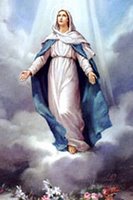
Does the Feast of the Assumption of Mary prove the early church believed in the Assumption?
Some Roman Catholics say the condemnation issued by Pope Gelasius of the early apocryphal literature about Mary’s Assumption was not a denial of the Assumption per se, but rather a condemnation of other spurious material contained in these books. I examined this argument here. Related to this is the following question:
“If Pope Gelasius really was condemning The Assumption, why was the Feast of the Assumption of the Blessed Mary allowed to be celebrated in the church?” This feast was being celebrated around the same time Pope Gelasius condemned the apocryphal writings containing the story of Mary’s Assumption (495 AD). Indeed, it does seem rather strange that Gelasius would allow a “Feast of the Assumption” but not a doctrine of the Assumption. The Catholic Encyclopedia verifies that the Feast was celebrated around the time of the condemnation byGelasius:
“According to the life of St. Theodosius (d. 529) it was celebrated in Palestine before the year 500, probably in August. In Egypt and Arabia, however, it was kept in January, and since the monks of Gaul adopted many usages from the Egyptian monks, we find this feast in Gaul in the sixth century, in January . The Gallican Liturgy has it on the 18th of January, under the title: Depositio, Assumptio, or Festivitas S. Mariae. This custom was kept up in the Gallican Church to the time of the introduction of the Roman rite. In the Greek Church, it seems, some kept this feast in January, with the monks of Egypt; others in August, with those of Palestine; wherefore the Emperor Maurice (d. 602), if the account of the "Liber Pontificalis" (II, 508) be correct, set the feast for the Greek Empire on 15 August.”
Well, this is only one Marian feast day of many. After the second half of the sixth century the organization of the Marian festivals was complete. Those having to do with her “person” came later than the earlier ones that focused on her role in the biblical narrative.
The Catholic Encyclopedia notes of the Assumption Feast, “Regarding the origin of the feast we are also uncertain. It is more probably the anniversary of the dedication of some church than the actual anniversary of Our Lady's death.” Note, “Our Lady’s death.” The festival said to celebrate her “Assumption” was more likely originally a celebration of a church dedication , but note also the other less likely option: her death, or her “passing over” or her “falling asleep” (koimesis). The festival probably first celebrated the day of her death, because death was viewed as the day of birth to the true heavenly life. That’s why the celebrations of particular Martyrs were celebrated on their death day. That word "koimesis" is used by Epiphanius:
“If the Holy virgin died and was buried, her falling asleep (koimesis) was surrounded with honor. Death found her pure and her crown is in her virginity. If she was killed- according to Luke 2:35- she is glorified among the martyrs and her holy body is blessed by which the light shone forth upon the world. Or whether she continued in life here, because nothing is impossible to God…No one knows her end.”
Source: Epiphanius, Panarion 78, 11 (as cited by Giovanni Miegge, The Virgin Mary: The Roman Catholic Marian Doctrine (Philadelphia: The Westminster Press, 1955), 85).
The Assumption feast evolved. Initially, the object of the feast was the blessed death of Mary, or her transition of her soul to heaven. As Meigge explains,
“The actual title of the Assumption (feast) does not necessarily mean the resurrection of the body or its elevation to heaven. The most ancient liturgical formulae maintain a wise reserve in regard to this, confining themselves to the statement- as does the Gregorian Sacramentary- that the holy Mother of God ‘underwent bodily death but could not be held by the chains of death’."
Source: Giovanni Miegge, The Virgin Mary: The Roman Catholic Marian Doctrine (Philadelphia: The Westminster Press, 1955), 95.






1 comment:
Also interesting (I don't know if you mentioned this or not), the Orthodox claim that Mary did die, but then her body was taken to heaven, "The Dormition of the Theotokos".
Also, the RC church where I have been substituting at (need the money, working for Catholic churches is a great source of anger, but I can mention that later) is sponsoring a lecture series by Mark Shea. One of his lectures is "Mary: The True Sacred Feminine" or something like that. Whatever term it was in the DaVinci Code. Just thought you might be interested in that... title.
Post a Comment